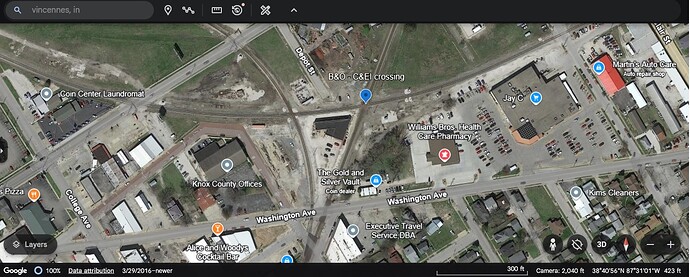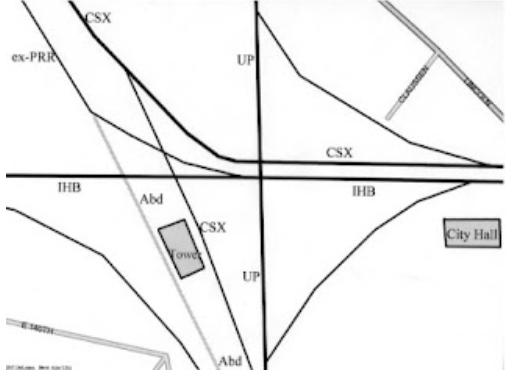Growing up in Chicago, I always had an interest in railroads. But, I must admit, I had never heard of the Chicago and Eastern Railroad until I took up model railroading in 2004. I quickly developed an interest in modeling Dearborn Station, and then it when I first became familiar with the C&EI Railroad.
The Chicago and Eastern Illinois Railroad (C&EI) was organized in 1877 as a consolidation of three other railroads: the Chicago, Danville and Vincennes Railroad, the Evansville, Terre Haute and Chicago Railroad and the Evansville and Terre Haute Railroad. Following this merger, the C&EI constructed a new line from Chicago to a Mississippi River connection in southern Illinois at Thebes. The city of Danville, Illinois, was the midpoint of the primary mainline between Chicago and Evansville, Indiana.
Founded in 1877, the C&EI prospered before being purchased by the Missouri Pacific Railroad (MP) and the Louisville and Nashville Railroad (L&N). The Missouri Pacific Railroad merged with C&EI in 1976, and MP was later acquired by the Union Pacific Railroad.
The C&EI was best known as a coal railroad, hauling coal to Chicago from mines in central Illinois and west central Indiana. It also provided passenger train service into downtown Chicago, using Dearborn Station of which it was part owner, connecting with the Chicago & Western Indiana track at Dolton, IL. Inside the Dearborn Station complex of freight houses, C&EI maintained two of the most prominent structures, the inbound and outbound freight houses.
The C&EI route began in what is now the southern suburbs of Chicago in the village of Dolon. From there, track ran south to Woodland Junction and then split southwest to St. Louis Missouri, south to Thebes, IL and Chaffee MO and southeast through Danville IL and Terra Haute IN to Evansville IN.
Source: Wikipedia
In 1902, the Frisco purchased a controlling interest in the Chicago and Eastern Illinois and made a connection between the two railroads at Pana, Illinois and later extended the line in Indiana to Evansville and a connection with the Ohio River. However, in 1913 financial problems led to the collapse of the Frisco, and the C&EI became independent once again.
The Missouri Pacific Railroad began to quietly purchase C&EI stock in 1961. After approval was gained from the Interstate Commerce Commission, the Missouri Pacific assumed control of the C&EI in May 1967. One of the stipulations of the merger required sale of C&EI’s Evansville line to the Louisville and Nashville Railroad in 1969. The line directly south of Chicago to near Danville was actually purchased by both MP’s and L&N’s successors, Union Pacific Railroad and CSX Transportation.
The C&EI was maintained as a separate subsidiary for the first few years, but Missouri Pacific merged it in 1976. The route from Woodland Junction, Illinois through Danville into Indiana became part of L&N and its successors (now CSX), while the western route toward Thebes and St. Louis became part of MP. Passenger service between Chicago and Danville was discontinued in 1971. In 1976, what remained of the C&EI was merged into the Missouri Pacific.
Source: Tuch Santucci's Chicago Sub of the Missouri Pacific / SCREAMING EAGLES
Prior to the MP takeover, the C&EI did not have a Chicago Sub. The line from Chicago to Evansville, IN was divided into two separate subdivisions. The Danville Sub was that portion of the line between Chicago and Danville, IL. The remainder of the route between Danville and Evansville was called the Evansville Sub. At Woodland Jct., the St. Louis Sub broke off towards Villa Grove to Findlay, IL where the line split again with one segment running to Pana, IL. The other route at Findlay went towards and through Salem and Thebes across the Mississippi River into Chaffee, Missouri. This portion was called the Salem Sub. The Southern Illinois & Missouri Bridge Company was used to cross the Mississippi River.
After the takeover of the C&EI by the Missouri Pacific, the line from Chicago through Woodland Jct., Villa Grove, Salem and Benton, IL was renamed the Chicago Sub. The Evansville Sub was extended to include the route between Danville and Woodland Jct. and the Danville Sub name was dropped. The Evansville Sub along with all the branch lines breaking from it became the Evansville Division. The line from Findlay to St Louis became the Pana Sub with MP purchasing the portion of the Pana Sub between Pana and Lenox from Conrail in 1983. The segment of the Salem Sub between Benton and Joppa became the Joppa Sub and between Joppa Jct. and Chaffee became the Thebes Sub.










